

Using the Emergency Flat Tire Repair Kit
About the Emergency Flat Tire Repair Kit
The emergency flat tire repair kit included with your Mazda is for a temporary repair of a slightly damaged flat tire resulting from running over nails or similar sharp objects on the road surface.
Perform the emergency flat tire repair without removing the nail or similar sharp object which punctured the tire.
Do not allow children to touch the tire sealant.
-
Ingestion of tire sealant is dangerous. In the event tire sealant is accidentally swallowed, drink large amounts of water immediately and seek medical assistance.
-
Tire sealant that comes into contact with the eyes and skin is dangerous. If tire sealant enters the eyes or contacts the skin, flush immediately with large amounts of water and seek medical assistance.
-
Your vehicle is not equipped with a spare tire. In the event of a flat tire, use the emergency flat tire repair kit to repair the tire temporarily. When doing the repair, refer to the instructions included in the emergency flat tire repair kit. If an emergency repair was performed on a flat tire using the emergency flat tire repair kit, have an Authorized Mazda Dealer, repair or replace the tire as soon as possible.
-
The tire sealant cannot be reused. Purchase new tire sealant at an Authorized Mazda Dealer.
-
The emergency flat tire repair kit cannot be used in the following cases.
Consult an Authorized Mazda Dealer.
-
The period of effective use for the tire sealant has expired. (The period of effectiveness is indicated on the bottle label.)
-
The tear or puncture exceeds about 4 mm (0.16 in).
-
The damage has occurred to an area of the tire other than the tread.
-
The vehicle has been driven with nearly no air remaining in the tire.
-
The tire has come off the wheel rim.
-
Damage to the wheel rim has occurred.
-
The tire has 2 or more punctures.
-
The emergency flat tire repair kit includes the following items.
U.S.A. and Canada
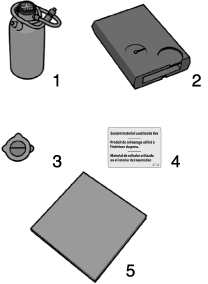
-
Sealant bottle
-
Compressor
-
Speed restriction sticker
-
Repaired tire sticker
-
Instructions
Mexico

-
Tire sealant
-
Injection hose
-
Compressor
-
Spare valve core
-
Valve core tool
-
Instructions
-
Speed restriction sticker
Using the Emergency Flat Tire Repair Kit
U.S.A. and Canada
-
Move the vehicle off the right-of-way to a safe place on a level and hard surface where the vehicle does not obstruct traffic.
-
Shift the shift lever to the 1 or Reverse (R) position for a manual transmission, and shift the selector lever to the P position for an automatic transmission.
-
Apply the parking brake with the brake pedal depressed and turn off the engine.
-
If necessary, flash the hazard warning lights and set up the roadside emergency triangle.
-
Unload passengers and cargo and remove the emergency flat tire repair kit.
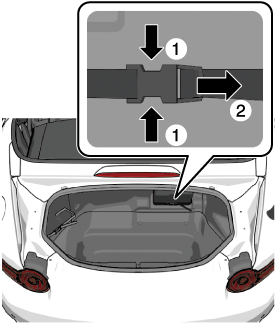
The location of the emergency flat tire repair kit may differ depending on the specification.
-
Shake the sealant bottle to mix the contents. Then extend the injection hose.

Do not shake the bottle excessively. Otherwise, the sealant could spray out of the injection hose, and if the sealant contacts clothing or other objects, you may not be able to remove it.
The sealant hardens easily and injecting it will be difficult under cold weather conditions (0 °C (32 °F) or below). Warm the sealant inside the vehicle to facilitate injection.
-
Pull out the air compressor hose and the air compressor plug from the air compressor.

-
Install the air compressor hose which was pulled out of the air compressor to the injection valve of the bottle.

Make sure that the air compressor switch is off before inserting the air compressor hose to the injection valve of the bottle. If the air compressor hose is not installed to the injection valve of the bottle securely, the sealant may leak.
-
Remove the valve cap from the valve of the flat tire, install the injection hose to the tire valve, turn the sleeve to the right, and tighten it.

-
Install the bottle to the air compressor and press it in until the left and right tabs are engaged securely.
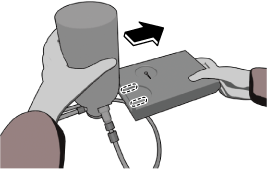
-
Insert the air compressor plug into the accessory socket inside the vehicle and switch the vehicle power to ACC (Search).
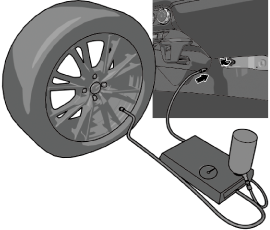
When inserting the air compressor plug into or removing it from the accessory socket, make sure that the air compressor switch is off. When turning the air compressor on/off, use the air compressor switch.
-
The sealant is injected into the tire when the air compressor is switched on. After the sealant is injected completely, wait until the tire inflation pressure increases to the specified tire inflation pressure.
Never use the air compressor above 300 kPa (3.1 kgf/cm2, 3 bar, 43.5 psi).
Using the air compressor at an inflation pressure above 300 kPa (3.1 kgf/cm2, 3 bar, 43.5 psi) continuously is dangerous. If the air compressor overheats, hot air will be exhausted and you could get burned.
-
The inflation pressure may increase to about 300 kPa (3.1 kgf/cm2, 3 bar, 43.5 psi) temporarily to inject the sealant through the valve. Normally, the inflation pressure decreases gradually and it reaches the actual inflation pressure after about 30 seconds.
-
Check the tire inflation pressure label driver's door frame for the correct tire inflation pressure.
-
Do not operate the air compressor for a continuous 10 minutes or longer because using it for long periods could cause a malfunction.
-
If the tire inflation pressure does not increase, repair of the tire is not possible. If the tire does not reach the specified tire inflation pressure within 10 minutes, it may have received extensive damage. In this case, the repair using the emergency flat tire repair kit was not successful. Contact an Authorized Mazda Dealer.
-
-
Adhere the speed restriction sticker in a place where it can be viewed easily by the driver.
Do not adhere the speed restriction sticker to the padded area on the steering wheel.
Adhering the speed restriction sticker to the padded area on the steering wheel is dangerous because the air bag may not operate (deploy) normally resulting in serious injury. In addition, do not adhere the sticker to areas where warning lights or the speedometer cannot be viewed.
-
Do not apply speed restriction stickers on the instrument panel or displays. Otherwise, the instrument panel or displays could be scratched or damaged when removing the sticker.
-
Remove the speed restriction sticker immediately after repair or replacement of a tire.
-
-
Adhere the repaired tire sticker to the wheel of the flat tire.
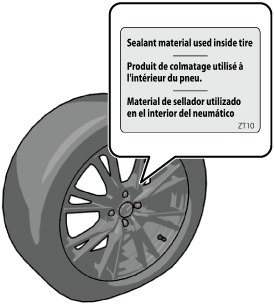
-
When the tire inflates to the specified tire inflation pressure, turn the air compressor switch off, turn the sleeve of the injection hose to the left, and pull it out of the tire valve.
-
Remove the air compressor hose from the injection valve of the bottle. After that, install the injection hose to the injection valve of the bottle to prevent leakage of any remaining sealant.
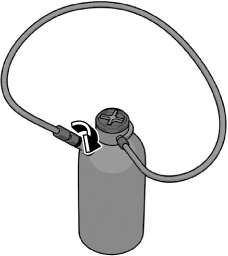
The remaining sealant in the hose may spray out when the hose is removed. Remove the hose carefully because you may not be able to remove the sealant contacting clothing or other objects.
-
Install the tire valve cap.
-
Put the emergency flat tire repair kit into the trunk.
-
Start driving immediately to spread the sealant in the tire.
Carefully drive the vehicle at a speed of 80 km/h (50 mph) or less. If the vehicle is driven at a speed of 80 km/h (50 mph) or more, the vehicle may vibrate.
If the tire is not properly inflated, the tire pressure monitoring system warning light
 will illuminate (Search).
will illuminate (Search). -
After driving the vehicle for about 10 minutes or 5 km (3 miles), connect the air compressor to the tire using Step 9 of the procedure, and check the tire inflation pressure using the tire pressure gauge on the air compressor. If the tire inflation pressure is lower than the specified tire inflation pressure, turn the air compressor on and wait until it reaches the specified tire inflation pressure.
If the tire inflation pressure has decreased below 130 kPa (1.3 kgf/cm2 or bar, 18.9 psi), stop driving and contact an Authorized Mazda Dealer.
The repair using the emergency flat tire repair kit was not successful.
If you see a decrease in the tire inflation pressure, even if Steps 9 to 20 of the procedure are performed repeatedly, stop driving.
Contact an Authorized Mazda Dealer.
Before checking the tire inflation pressure using the tire pressure gauge, turn the air compressor switch off.
-
The emergency flat tire repair is completed successfully if the tire inflation pressure does not decrease. Carefully drive the vehicle to the nearest Authorized Mazda Dealer immediately and have the flat tire replaced. Replacement with a new tire is recommended. If the tire is to be repaired or reused, consult an Authorized Mazda Dealer.
-
If an emergency flat tire repair has been performed using the emergency flat tire repair kit, Mazda recommends that the tire be replaced with a new one as soon as possible. If the tire is to be repaired or reused, consult an Authorized Mazda Dealer.
-
The wheel can be reused if the sealant adhering to it is removed. However, replace the valve with a new one.
-
Mexico
-
Park on a level surface off the right-of-way and set the parking brake.
-
Put a vehicle with an automatic transmission in Park (P), a manual transmission in Reverse (R) or 1, and turn off the engine.
-
Turn on the hazard warning flasher.
-
Unload passengers and luggage, and remove the emergency flat tire repair kit.

The location of the emergency flat tire repair kit may differ depending on the specification.
-
Shake the tire sealant well.
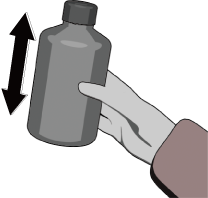
If the bottle is shaken after the injection hose is screwed on, tire sealant could spray out from the injection hose. Tire sealant contacting clothing or other objects may be impossible to remove. Shake the bottle before screwing on the injection hose.
The tire sealant can be used at outside temperatures down to -30 °C (-22 °F).
In extremely cold temperatures (0 °C (32 °F) or below), the tire sealant hardens easily and injection of the sealant will be difficult. Warm the sealant inside the vehicle before doing the injection work.
-
Remove the cap from the bottle. Screw on the injection hose with the bottle's inner cap left on to break the inner cap.
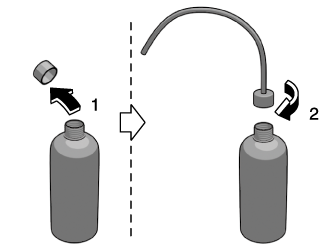
-
Remove the valve cap from the flat tire. Press the back of a valve core tool to the core of the tire valve and bleed all the remaining air.
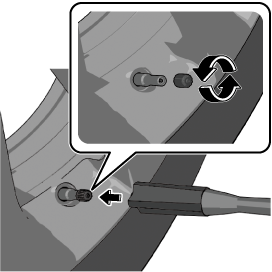
If there is air remaining in the tire when the valve core is removed, the valve core could fly out. Remove the valve core carefully.
-
Turn the valve core counterclockwise with the valve core tool and remove the valve core.
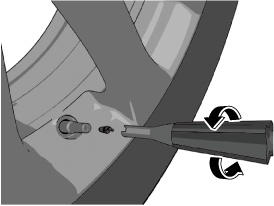
-
Insert the injection hose into the valve.
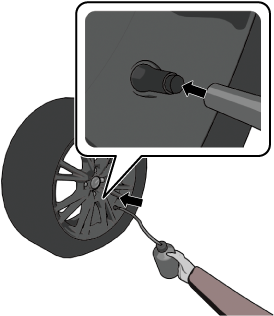
-
Hold the bottom of the bottle upright, squeeze the bottle with your hands, and inject the entire amount of tire sealant into the tire.
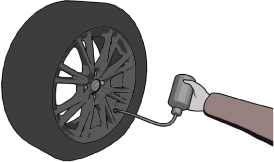
-
Pull out the injection hose from the valve. Reinsert the valve core into the valve and turn it clockwise to install it.
After that, install the injection hose to the tab of the bottle to prevent leakage of any remaining sealant.
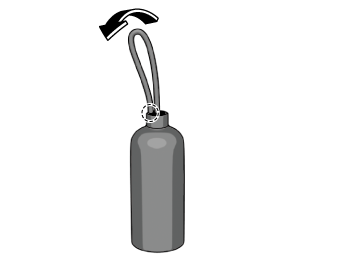
Do not throw away the empty tire sealant bottle after use. Return the empty tire sealant bottle to an Authorized Mazda Dealer when replacing the tire. The empty tire sealant bottle will need to be used to extract and dispose of the used sealant from the tire.
-
Adhere the speed restriction sticker in a place where it can be viewed easily by the driver.
Do not adhere the speed restriction sticker to the padded area on the steering wheel.
Adhering the speed restriction sticker to the padded area on the steering wheel is dangerous because the air bag may not operate (deploy) normally resulting in serious injury. In addition, do not adhere the sticker to areas where warning lights or the speedometer cannot be viewed.
-
Do not apply speed restriction stickers on the instrument panel or displays. Otherwise, the instrument panel or displays could be scratched or damaged when removing the sticker.
-
Remove the speed restriction sticker immediately after repair or replacement of a tire.
-
-
Pull out the air compressor hose and the air compressor plug from the air compressor.

-
Install the compressor hose to the tire valve.

-
Insert the compressor plug into the interior accessory socket and switch the vehicle power to ACC (Search).
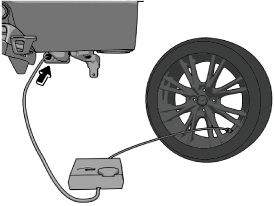
-
Before pulling out the compressor plug from the electrical socket, make sure the compressor power switch is off.
-
The compressor turns on and off with the push-button switch.
-
-
Turn the compressor switch on and inflate the tire carefully to the correct inflation pressure.
Never operate the compressor above 300 kPa (3.1 kgf/cm2, 3 bar, 43.5 psi).
Operating the compressor above 300 kPa (3.1 kgf/cm2, 3 bar, 43.5 psi) is dangerous. When the inflation pressure rises above 300 kPa (3.1 kgf/cm2, 3 bar, 43.5 psi), heated air will be exhausted from the back of the compressor and you could be burned.
-
Check the tire inflation pressure label (driver's door frame) for the correct tire inflation pressure.
-
Do not use the compressor for longer than 10 minutes because using the compressor for long periods could damage it.
-
If the tire does not inflate, repair of the tire may not be possible. If the tire does not reach the correct inflation pressure within a 10-minute period, it probably has received more extensive damage. When this happens, the emergency flat tire repair kit cannot be used to repair the tire. Contact an Authorized Mazda Dealer.
-
If the tire has been over-inflated, loosen the screw cap on the compressor and bleed some of the air out.
-
-
When the tire has been inflated to the proper inflation pressure, turn the compressor switch off and remove the compressor hose from the tire valve.
-
Install the tire valve cap.
-
Put the emergency flat tire repair kit in the trunk and continue driving.
-
Drive carefully to an Authorized Mazda Dealer and keep the vehicle speed below 80 km/h (50 mph).
-
If the vehicle is driven 80 km/h (50 mph) or higher, the vehicle might begin to vibrate.
If the tire is not properly inflated, the tire pressure monitoring system warning light
 will illuminate (Search).
will illuminate (Search). -
-
After driving the vehicle for 10 minutes or 5 km (3 miles), connect the air compressor to the tire using Step 14 of the procedure, and check the tire pressure with the tire pressure gauge equipped with the compressor. If the tire pressure has fallen below the correct tire pressure, inflate the tire to the correct pressure again following the steps from number 15.
-
If the tire inflation pressure falls below 130 kPa (1.3 kgf/cm2 or bar, 18.9 psi), repair cannot be done with the repair kit. Park the vehicle on a level surface off the right-of-way and contact an Authorized Mazda Dealer.
-
If the tire inflation pressure continues to remain low after repeating steps 14 to 20, park the vehicle on a level surface off the right-of-way and contact an Authorized Mazda Dealer.
When checking the tire inflation pressure with the tire pressure gauge on the compressor unit, make sure the compressor switch is turned off.
-
-
The emergency flat tire repair is completed if the tire air pressure does not decrease. Drive the vehicle carefully to the nearest Authorized Mazda Dealer promptly and have the tire replaced. Mazda recommends that the tire be replaced with a new one. If the tire is to be repaired and reused, consult an Authorized Mazda Dealer.
Peel off the speed restriction sticker after replacing the tire.
-
For a tire which has undergone an emergency flat tire repair using the emergency flat tire repair kit, Mazda recommends that the tire be replaced with a new one as soon as possible. If the tire is to be repaired and reused, consult an Authorized Mazda Dealer.
-
The wheel can be reused after any sealant adhering to it is wiped off and carefully inspected. However, replace the tire valve with a new one.
-


